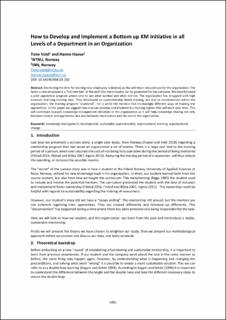| dc.contributor.author | Vold, Tone | |
| dc.contributor.author | Haave, Hanne Marit | |
| dc.date.accessioned | 2020-09-16T10:31:22Z | |
| dc.date.available | 2020-09-16T10:31:22Z | |
| dc.date.created | 2019-09-16T10:37:26Z | |
| dc.date.issued | 2019 | |
| dc.identifier.issn | 2048-8971 | |
| dc.identifier.uri | https://hdl.handle.net/11250/2678043 | |
| dc.description.abstract | Training and turnover represent two major costs in an organization. A few years ago, the director of education of a company in Norway introduced different ways of reducing the training period and the turnover. By utilizing what he had learned in the knowledge management courses, he managed to dramatically reduce the training period, and also the turnover was reduced. Utilizing principles like Communities of Practice (CoP) (from Lave&Wenger) and using techniques from Liberating Structures (see: Liberatingstructures.com) the co-workers developed and implemented a form of apprenticeship. Using CoP’s allowed the co-workers to cooperate on how the learning and training should be done, and the Liberating structures were tools to get people talking. When implemented this reduced the training period significantly. Also the turnover rate dropped. However, they discovered another problem; some of the mentors had outdated knowledge and thus trained the students to some extent to work based on outdated information. When the director of education were engaged in other tasks and did not closely follow up the process further, the mentorship and communities faded and now only occur occasionally. How is this possible? How can a “perfect” system fail? How can these initiatives that were so successful just fade away? Changes in organizations need to be founded properly in the organization in order to be sustainable. Changes introduced by individuals need thus to be implemented in such a way that it is not relaying on the individuals, but is adopted as a part of the strategy and execution of strategy in the organization. This paper present possible explanations as to how the change did not sustain, and also present suggestions towards how this can be set up to be more sustainable. We will present views from employees and managers. This data are collected through interviews. | en_US |
| dc.language.iso | eng | en_US |
| dc.subject | knowledge management | en_US |
| dc.subject | organizational change | en_US |
| dc.subject | mentorship | en_US |
| dc.title | How to Develop and Implement a Bottom up KM Initiative in all Levels of a Department in an Organization | en_US |
| dc.type | Peer reviewed | en_US |
| dc.type | Journal article | en_US |
| dc.description.version | publishedVersion | en_US |
| dc.subject.nsi | VDP::Samfunnsvitenskap: 200 | en_US |
| dc.source.pagenumber | 1091-1095 | en_US |
| dc.source.journal | Proceedings of the 20th European conference on knowledge management | en_US |
| dc.identifier.doi | 10.34190/KM.19.150 | |
| dc.identifier.cristin | 1724981 | |
| cristin.unitcode | 209,6,4,0 | |
| cristin.unitname | Institutt for organisasjon, ledelse, styring | |
| cristin.ispublished | true | |
| cristin.fulltext | original | |
| cristin.qualitycode | 1 | |
